Think you can’t bake fresh, homemade sourdough bread? This easy sourdough bread recipe—trusted by beginner bakers for over a decade—shows you how, step-by-step. No yeast. No kneading. No noise. Just simple ingredients and 10 minutes hands on time for soft, crisp sourdough bread at home.
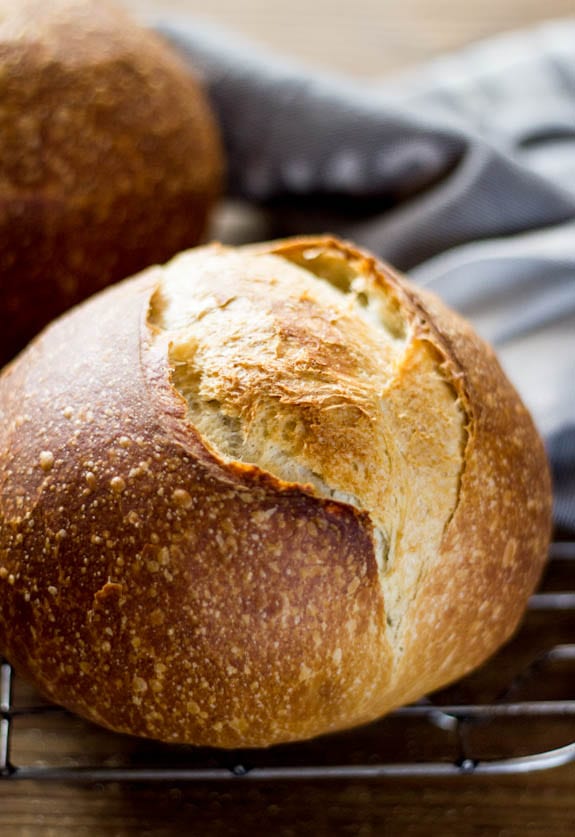
Reader review
“I have tried MULTIPLE sourdough bread recipes and this one has been the very first to make a successful (fully risen) loaf of bread. I am relatively new to sourdough and for some reason, the other recipes just didn’t produce good bread. These instructions and detailed explanations really make a huge difference to someone who is new to the world of sourdough.”
—Savannah
To anyone who thinks their sourdough bread isn’t good enough, I get it. Back in 2013, I set a goal: bake more bread. I tested, failed, succeeded (and tried again). What began with an easy no-knead artisan loaf eventually led to the holy grail: homemade sourdough bread.
Admittedly, I had beginner’s luck. My early loaves were light, plump and airy, everything you want sourdough to be! And then? Down the rabbit hole I went: Hydration? Baker’s %? Proofing times?
Now, with 13+ years baking experience and a professional culinary background, I know what holds people back: the confusion, hesitation, comparison. I teach from a straight forward practical perspective because sourdough is not just a written recipe; it’s an understanding.
This recipe has been the most popular on my blog for over a decade- millions of views and the inspiration behind my bestselling book Artisan Sourdough Made Simple, a deeper dive into sourdough bread recipes. So, if you’re at the end of your rope (and just want to make good bread), you’ve made it. Welcome to the journey.
What Sets My Recipe Apart:
- One bowl, 5 ingredients
- Olive oil = soft, plush crumb & crisp, golden crust
- No stand mixer
- No bread machine
- Flexible baker’s schedule
- Personalized support in the comments
But before we make bread, let’s discuss what drives it: your sourdough starter. Once you understand what it is, and how it works, your path will be crystal clear. Have questions? Ask in the comment section. I respond with personalized help.
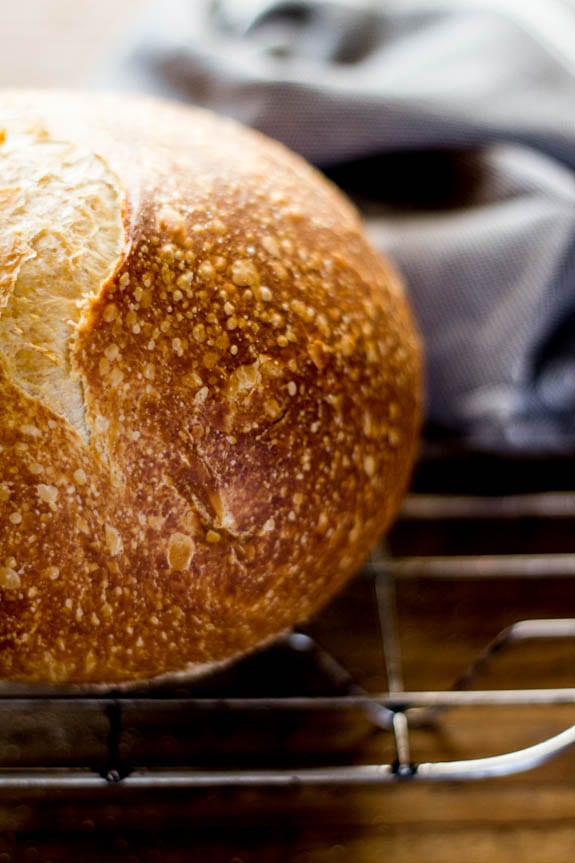
Where To Get A Sourdough Starter
A sourdough starter is a live fermented culture of flour and water. It naturally leavens bread dough without commercial yeast. There are all different types: homemade, purchased or gifted (ask a fellow baker!). I use two different starters at home: one I made myself, and a vibrant Australian starter gifted from my friend Celia.
But is doesn’t stop there. Once your have a starter, it must be kept alive and well with regular feedings to maintain its rising power. Sourdough is not static; it’s a living process. Here’s my personal feeding schedule which you can adapt to suit your style:
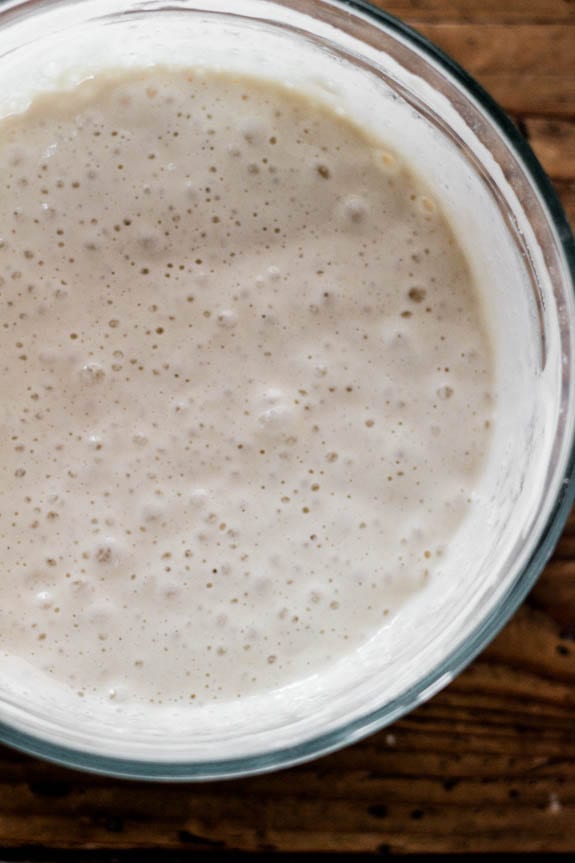
How To Feed Sourdough Starter
- Remove and discard half of your sourdough starter
- Feed what’s left in the jar with equal parts flour and water by weight (1:1:1 feeding ratio).
- Let rise at room temperature (loosely covered or airtight) ideally 75+F until bubbly, active and double in size (2-12 hrs). I use this sourdough starter jar.
Recommended Reading: Feeding Sourdough Starter: My Best Tips & Tricks
When Is Sourdough Starter Ready To Use?
Your fed starter is ready to use when it’s bubbly, active and doubles in size. This can take 2-12 hours or more depending on the temperature and strength of your starter. My best advice? Be patient, plan ahead, and make sure your starter is in a warm spot (ideally 75 F). The process is not instant.
Float Test: If you’re unsure whether your starter is ready, drop 1 tsp at peak height into a glass of water. If it floats to the top it’s ready to use. If it sinks, feed your starter again.
Storing Your Starter
Most people don’t realize that your feeding schedule is directly related to your baking preferences. If you only bake a few times a month, store your starter in the fridge and feed it once a week. If you bake often, store it at room temperature and feed it once a day.
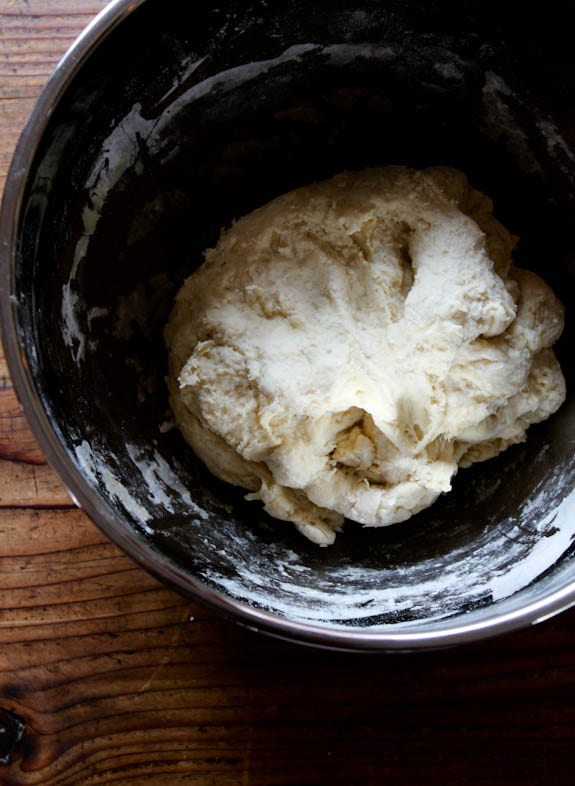
How To Make Sourdough Bread: Step-By-Step Recipe
To Start: Feed your starter until it’s bubbly and active first (remember this can take anywhere from 2-12 hours, so plan ahead). Then mix the dough. Detailed instructions follow below. For a printable recipe & sample baking schedule, scroll to the end.
Step 1: Mix The Dough
- Add water, sourdough starter, and olive oil to a large bowl. Whisk well to combine, making sure the starter is fully dissolved. Then add the bread flour and salt. Continue mixing (I use a fork at this point) until the flour is absorbed. The dough will feel rough and shaggy, which is normal.
- Cover the bowl and let rest (autolyse) for 30 minutes to 1 hour at room temperature. Then shape the dough into a rough ball (it doesn’t have to look perfect).
Tip: Weigh your ingredient with a digital kitchen scale. Measuring cups vary in size and don’t account for ingredient density which can lead to dry, dense, or overly sticky dough.
Why Autolyse Matters
Autolyse is the first rest after mixing bread dough. It jumpstarts gluten development without kneading, making the dough stronger, stretchier, and easier to shape I never skip it. For this recipe, rest for at least 30-45 minutes (or when time permits, I’ll do 1 hour for an even softer, more manageable dough). To learn more about common sourdough bread terms read my Sourdough Baking Glossary. I’ve included the only 12 you need to know!
A Note on Salt: Some bakers only add salt after autolyse, believing it slows down gluten development. I’ve followed that method for years, but now mix everything at once. It’s simpler, faster, and still makes excellent loaves (plus, you won’t forget to add the salt later on!). I’ll leave the choice up to you.
Want To Add Inclusions?
Mix in flavor additions after autolyse, when the dough is softer and more pliable. This is another reason not to skip the autolyse step. Alternatively, inclusions can be added during the first stretch and fold.
A few ideas:
- Roasted garlic
- Chopped olives
- Fresh or dried herbs (rosemary, thyme)
- Seed or nuts
- Cheese
- Dried fruit (raisins, cranberries)
- Jalapeños

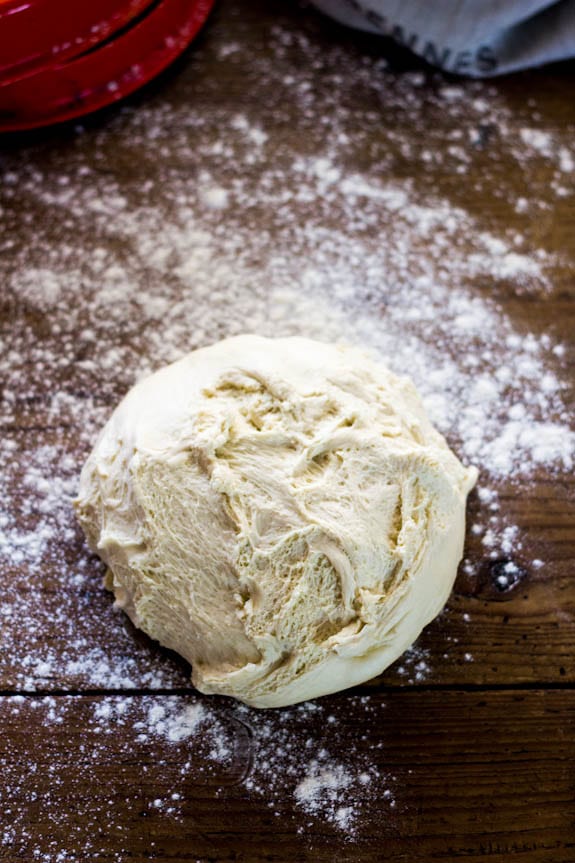
Step 2: Bulk Rise
Now the dough is ready to rise. Cover the bowl with lightly oiled plastic wrap so the dough doesn’t stick to the top, or transfer to a dough tub. Let rise at room temperature, about 68-70 F (20-21 C).
How Long Does It Take For Sourdough Bread To Rise?
The dough is ready when it’s puffy, slightly domed and nearly double in size. This can take 3-12 hours depending on room temperature, the quantity and strength of your sourdough starter, and seasonal conditions. All variables work together. See my example below:
For My Sourdough Bread Recipe (with ~150 g sourdough starter):
- In the summer: ~2-4 hours @ 80 F (26 C)
- In the winter: ~10-12 hours @ 68 F (20 C)
Diving Deeper: Temperature controls time. This is where I see the majority of beginner baker’s make mistakes- the temperature is overlooked. Sourdough takes longer to rise than yeasted bread, and it’s highly dependent on your specific environment. My kitchen might be 75 F. Yours? 68 F. Watch the dough, not the clock. For more details and troubleshooting read my companion article: Why Won’t My Sourdough Bread Rise?
Stretch And Fold The Dough (Optional Step)
About 30 minutes into the bulk rise, you can perform a series of “stretch & folds” to strengthen the bread dough. This step is not mandatory; however it has the potential to add height and structure to the finished loaf. Check out my how to stretch and fold sourdough guide to learn more, step-by-step. It’s easy and fun to do!
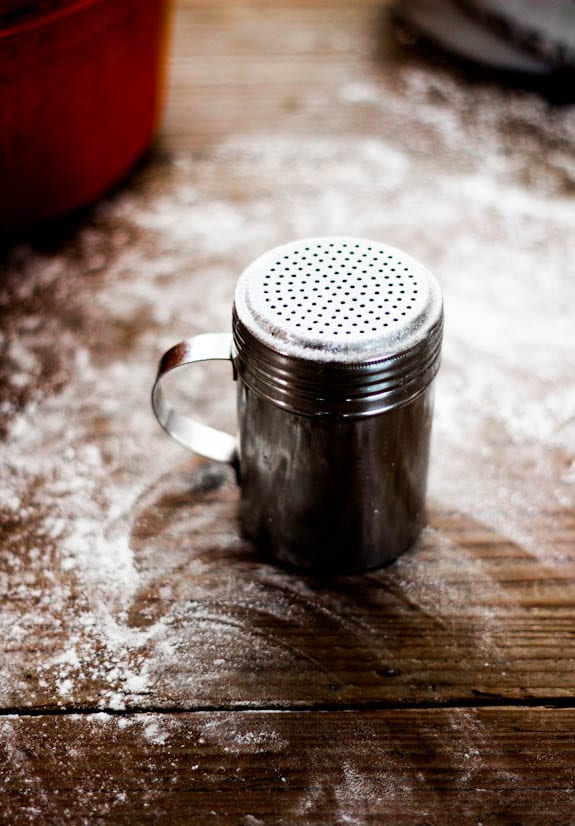
Step 3: Divide & Shape The Dough
At this stage, remove the dough onto a lightly floured surface. For two smaller loaves, divide the dough in half. For a single, standard size loaf leave it whole.
How To Shape A Round Sourdough Boule (Loaf)
Starting at the top, fold the dough over toward the center. Give it a slight turn, and then fold over the next section of dough. Repeat until you have come full circle to form a tight round. This creates surface tension for better oven spring. You can also try the envelope-style fold.
Tip: I used to get so nervous when shaping bread dough because you only had one chance to get it right. So intuitively, I would practice using a piece of Play-Doh or with a kitchen towel to go through the motions at my own pace.
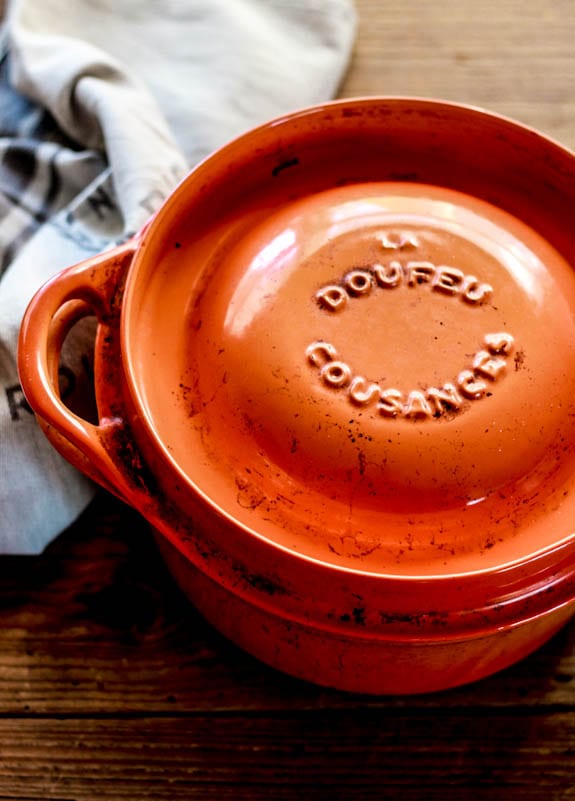
Step 4: Choose The Right Baking Pot
If you want bakery-style results, bake sourdough bread in a Dutch oven. Why? Pots trap steam which is the secret to homemade sourdough with bold rise and golden crust. Without steam, the crust will set too fast casing the loaf to harden, split or bake unevenly (I’ve been there and it’s not pretty).
What If You Don’t Have A Dutch Oven?
You’ll need another oven-safe pot with a lid to create steam. It must be able to withstand up to 450 F/232 C (lid and handles included).
A few options:
- Enamel roasting pan with lid (or sheet pan to cover)
- Cast iron skillet with upside down roasting pan to cover
- Covered sandwich loaf pans
- Clay Baker or Romertopf (soaked first)
- Preheated baking stone w/ metal bowl to cover
Here’s what happened to me: I tried the “no pot” baking route in the past, using just about everything from pizza stones, to baking sheets with no luck! The crust always hardened too quickly. Then I tried various steaming methods to remedy this (e.g. ice cubes in a hot pan, spraying my loaves with water) but my personal oven could not retain enough moisture. The environment was always too dry. For me, using a Dutch oven was the only reliable solution that worked with consistent results.
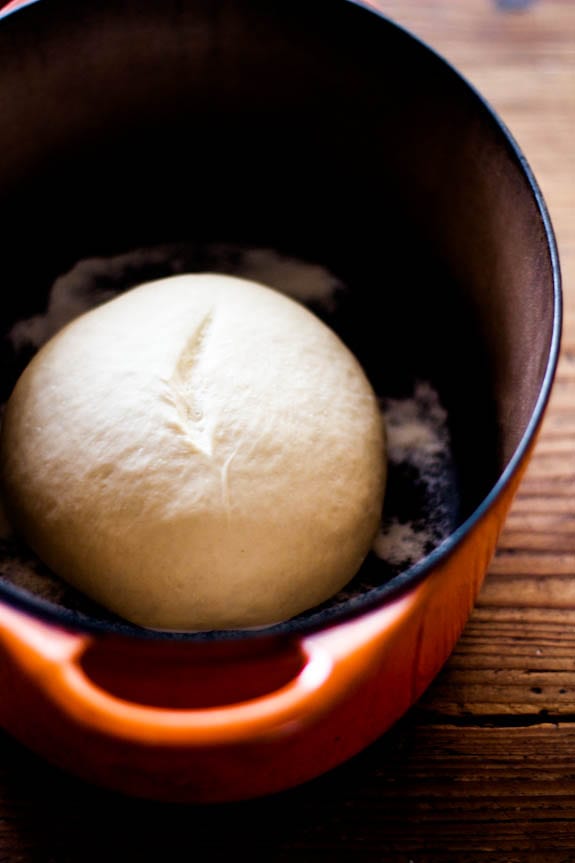
Step 5: Second Rise (Proofing)
- After shaping, your dough needs to rise again. To do so, generously dust the bottom of your Dutch oven with cornmeal, or line with non-stick parchment paper to prevent sticking. Gently place the dough inside (see tip below)
- Let the dough rise for 30 minutes to 1 hour, or until it’s visibly puffy and no longer feels dense. It doesn’t need to double in size. While the dough proofs, preheat your oven to 450 F (232 C).
Tip: Want better shape and structure? Proof the dough in a cloth-lined, 8-inch bowl or banneton instead of directly in the Dutch oven. This will contain the dough and hold its shape without spreading.
Step 6: Score The Dough
- Right before the dough goes into the oven, make a shallow slash down the center of the dough, about 2-3 inches long. Use a sharp serrated knife, paring knife or bread lame. This lets the steam escape, and allows the bread to “bloom” or expand in the oven.
- Admittedly, this step is a bit nerve racking, so I don’t want to gloss over it. Be quick and confident. I’ll share what my sourdough mentor told me: “Slash with panache!”
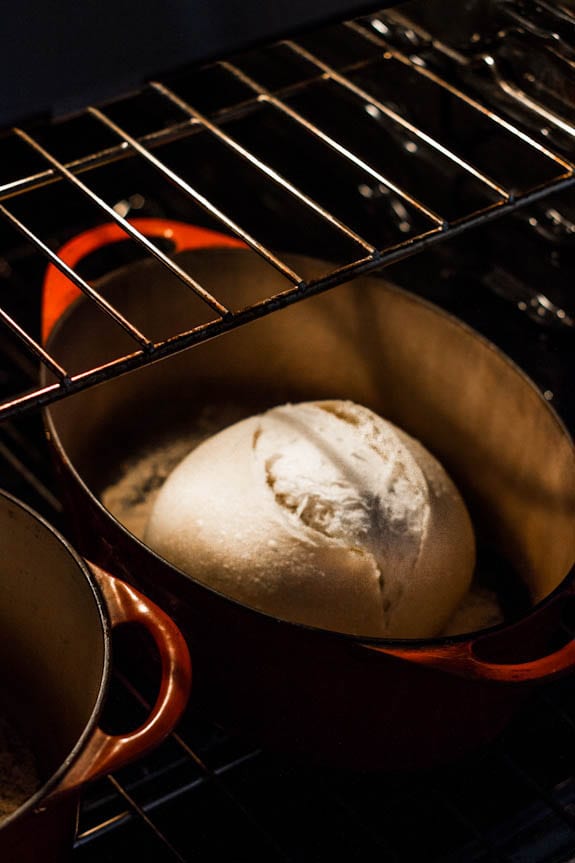
Step 7: Bake The Bread
You’re at the finish line now! Bake on the center rack (lid on) for 20 minutes. Then remove the lid. Your bread will look pale and slightly shiny. Then finish baking (uncovered) for 40 minutes or until the crust is deep golden brown. The internal temperature should be 205-210 F/96-98 C.
Tip: During the last 10 minutes of baking, crack open the oven door to let the moisture out. This creates a crispier crust. Or, remove the bread from the pot and bake directly on the oven rack. The latter creates the crispiest finish.
Step 8: Cool & Slice
Cool the bread on a wire rack for at least 1 hour before slicing. Be patient! If you cut into it too soon, the texture will be damp and gummy. Life’s too short for sub par bread.
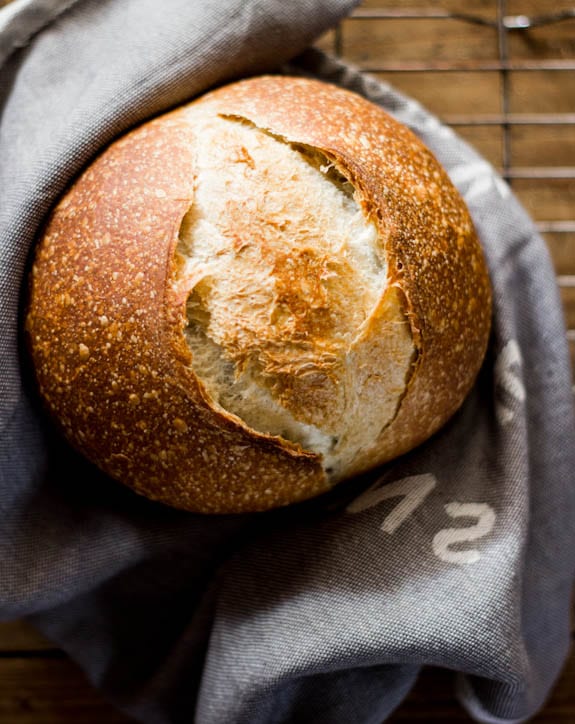
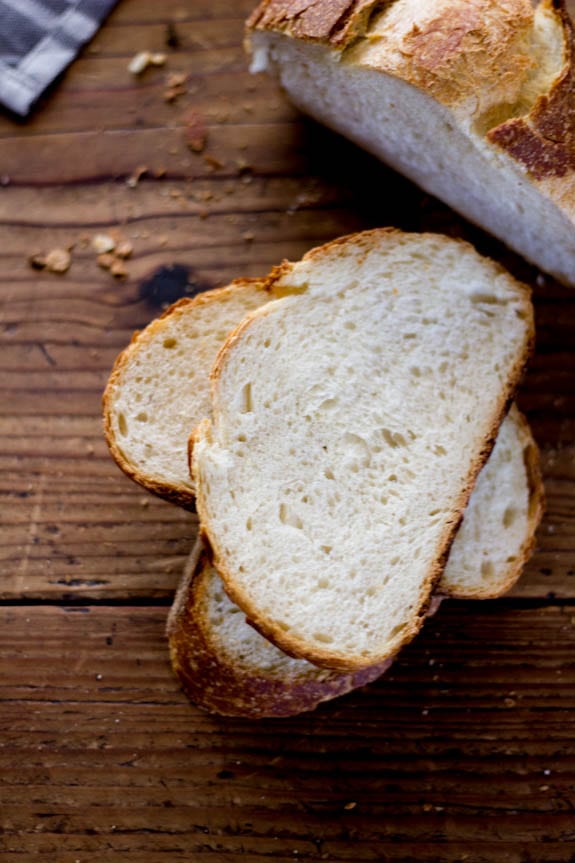
Final Thoughts
There are a gazillion sourdough bread recipes out there. No two loaves look alike. Start with this guide, master the basics and then branch out: try my golden sourdough focaccia recipe, this easy sourdough sandwich bread, or my one-bowl sourdough pancakes for breakfast! Once you have a few loaves under your belt, the process will become an imminent rhythm and you’ll become a sourdough pro in no time.
Sourdough Baking Schedule
- Friday Evening: Feed your starter, cover the jar, and leave it on the counter overnight. If you keep your starter in the fridge, it might need two feedings to perk back up (feed it in the morning & in the evening).
- Saturday Morning: Check your starter: if it’s alive and bubbling, you can make the dough to rise during the day. Or, feed it again in the afternoon to make the dough in the evening for an overnight rise. Remember to use the float test mentioned above to make sure your starter is ready to use.
- Saturday Morning/Evening (or whenever your starter is ready): Make the dough. Leave on the counter to bulk rise at room temperature. In the summer, if your dough rises quickly and you’re not ready to bake, cover the whole bowl with lightly oiled wrap and chill until ready to use.
- Sunday Morning: cut and shape the dough. Place in Dutch oven for second rise. Slash. Bake. Cool. Eat.
By signing up, you agree to receive emails from The Clever Carrot. Unsubscribe at any time.

Sourdough Bread: A Beginner’s Guide
- Prep Time: 13 hours
- Cook Time: 1 hour
- Total Time: 14 hours
- Yield: 1 loaf 1x
- Category: Sourdough Bread Recipes
- Method: Oven-Baked
- Cuisine: American
- Diet: Vegan
Description
New to sourdough? This easy beginner sourdough bread recipe makes the best artisan-style loaf at home with just 5 simple ingredients: bread flour, active sourdough starter, water, salt and olive oil—my signature addition—known for creating a light, plush crumb and a crisp golden crust. Follow my clear, step-by-step instructions and video guidance to bake fresh sourdough bread with confidence (even on your first try!).
Ingredients
- 150g bubbly, active sourdough starter
- 250g warm water (see Note 2)
- 25g olive oil
- 500g bread flour (not all purpose flour)
- 10g fine sea salt
- fine ground cornmeal or non-stick parchment paper
Notes, Tips & Equipment
- For best results, please weigh your ingredients using a digital scale. Because measuring cups vary in size and shape, they are not accurate for bread baking. You want the flour to water ratio to be correct!
- For a more soft and pliable dough, you can increase the water up to 300 g- 325 g total. Please use a cloth lined bowl or proofing basket (instead of the Dutch oven) for the second rise.
- You will need a 5 1/2 or 6 quart Dutch oven for baking
- This recipe was tested with King Arthur Bread Flour, Gold Medal Bread Flour, Pillsbury Bread Flour
Instructions
Make The Dough
In a large bowl, add the sourdough starter, water and olive oil. Mix with a fork to combine. Add the flour and salt. Continue mixing with your fork until the dough becomes stiff. Then squish everything together with your hands to incorporate all of the flour. The dough will be dry and shaggy.
Cover the bowl with plastic wrap, reusable wrap or a clean, very damp kitchen towel. Let rest (autolyse) for 30 minutes or up to 1 hour, if preferred.
After the dough has rested: return to the bowl and work the dough into a rough ball, about 15 seconds.
Note: For the dough, I’ve given a range in water quantity (see ingredient list above). If using 250 g of water, the texture at this stage will be quite dry and stiff. If using an increased amount of water, approximately 300-325 g, the dough will be more wet. Both textures are normal, depending on which route you take.
Bulk Rise
Cover the bowl with lightly oiled plastic wrap (alternatively, transfer the dough to a high-sided dough tub with lid and measuring marks). Let rest in a warm spot to rise, ideally 70-75 F. The dough is ready when it no longer looks dense and has almost doubled in size.
Note: The bulk rise time can take anywhere from 3-12 hours depending on the temperature of your ingredients, the potency of your sourdough starter, and your current room temperature. This will be different for everyone. For example, in the summer rise times can take anywhere between 2-4 hours @ 80 F/ 26 C whereas in the winter, the dough will take about 10-12 hours @ 68º F/ 20º C. Watch the dough and not the clock.
Optional Step: Stretch & Fold The Dough
During bulk rise, you have the option to perform a series of ‘stretch & folds’ to strengthen the dough. Start 30-45 minutes into the bulk rise. Gather a portion of the dough, stretch it upwards and then fold it over itself. Rotate the bowl ¼ turn and repeat this process until you have come full circle to complete 1 set. Do this once or twice spaced about 1 hour apart. Although this step is not mandatory, it has the potential to increase the total volume and height of your bread. Click here for a step-by-step video tutorial.
Note: Doughs made with 250 g of water vs. 300-325 g of water will feel completely different. The former will be more stiff; the latter will have more elasticity. When in doubt, always give the dough extra rest time in between sets if it won’t stretch with ease.
Shape The Dough
Remove the dough from the bowl onto a lightly floured surface. You do not need to ‘punch down’ the dough; it will gently deflate as you fold and shape it.
To shape: Starting at the top, fold the dough over toward the center. Give it a slight turn, and then fold over the next section of dough. Repeat until you have come full circle. Then flip the dough over and place it seam side down. Using your hands, gently cup the sides of the dough and rotate it, using quarter turns in a circular motion. You can also pull it towards you to even out the shape. Repeat this process until you are happy with its appearance.
Note: When shaping, the idea is for the dough to catch enough surface tension on a non-floured area in order to create a tight ball. If there is flour present, it will slide around… and drive you nuts.
Second Rise
Now the dough needs to rise again, but for a shorter period of time. If you’ve used 250g water in your dough, you can do a free form second rise in the Dutch oven (if not, see note directly below). Coat the bottom of your Dutch oven with cornmeal. Alternatively, use parchment paper to prevent sticking (this is what I do, now). Place the dough inside of the pot, cover and let rise for about 30 minutes to 1 hour. The dough ready when it is slightly puffy but not double in size. Preheat your oven to 450 F/ 232 C towards the tail end of the second rise.
Note: If your dough contains more than 250g water, omit the free from rise. Your dough will spread. You’ll need to do the second rise in a cloth-lined, floured proofing basket instead. The basket will hold its shape to prevent spreading.
Score The Dough
Right before your bread goes into the oven, make a shallow slash about 2-3 inches long (or more) in the center of the dough. Use a bread lame, razor blade, sharp paring or a small serrated steak knife. The cut should be about 1/4-inch deep.
Bake The Dough
Place the bread into the oven on the center rack (lid on) and reduce the temperature to 400° F/ 204° C. Bake for 20 minutes. Remove the lid, and continue to bake (uncovered) for an additional 40 minutes or until deep, golden brown. Keep in mind that all ovens are different; you might have to make minimal adjustments to these temperatures.
You can also take the internal temperature of your bread to double check that it is done. For sourdough, it should read about 205-210º F/ 96-98º C.
Remove the bread from the oven, and cool on a wire rack for at least an hour before slicing. Don’t cut too soon or else the inside will have a damp and gummy texture.
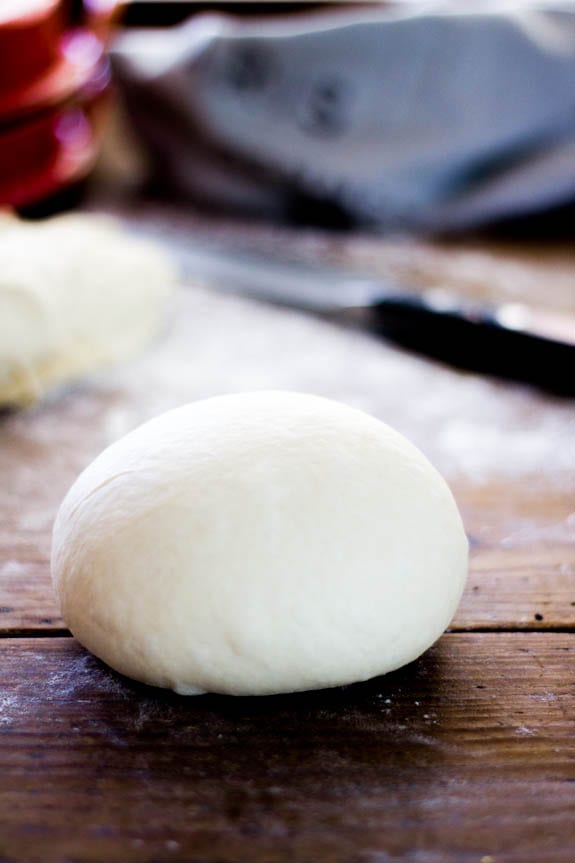
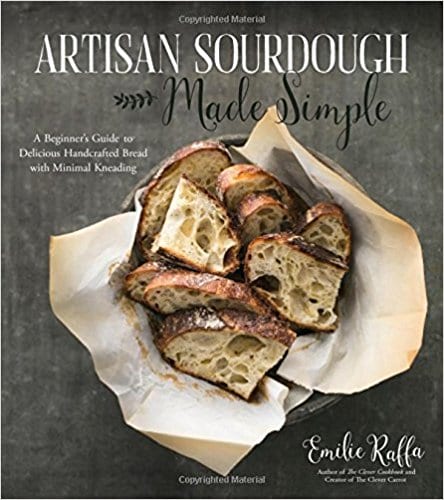


Comments
Robyn Burgess says
Hi, with the water 300gto 325g after bulk rise can you do the same as the water 250g and place in banneton and put in fridge over nite and bake in the morning.Cheers Robyn
Vanessa says
Hello! I started out with your focaccia recipe and we have been enjoying that for about two months. I can’t keep up with with how much of it my teenage boys eat! I’m ready to try an actual loaf, and I’m wondering if the dough tub should be lightly oiled like it is in the focaccia recipe even though it isn’t mentioned in this recipe. Please let me know, I love following your recipes exactly because they’ve all been amazing. The brownies have been a family favorite.
Chris says
Hi Emilie,
I just started making sourdough and have used this recipe several times with great results, so good in fact I bought your book. I noticed that the recipe in the book is different than this one and wanted to ask why the change? Also the recipe in the book does not mention turning down the oven temperature before putting the bread in the oven.
Cadence W says
I am a young baker (Middle schooler) who chose to use your recipe for a science fair projrct because it stood out! It was amazing but, I was wondering when I make my loaf am I supposed to wait every hour to do a fold and stretch or do I do the fold every 30 min for the first couple of hours. I tried many different recipes and they all had mixed opinions. Since you seem so knowledgeable I wanted to ask you! Thank You!
Jessica Faraci says
I cannot have olive oil (allergy to fruit) can i substitute with butter? Ghee?
Phil says
Wow…. First time sourdougher with a perfect result,
Jari says
Hi there! I’ve baked this bread before and it is AMAZING!! I am wondering 2 things: 1) can i sub some of the water for milk? Would that impact the rising time? And 2) Would i be able to add a little sugar, vanilla and chocolate chips? I’ve been dying to try this but don’t know where to start! Thanks so much!!
Amanda says
HEAVENLY. I just made my first loaf EVER and I’m so glad I used your recipe! I can’t believe I made this.
I baked for 20 mins covered and 20 uncovered at 450 degrees to help keep the bottom from browning too much(recommendation from a friend) and I used a 4.5qt pot. This will be my go-to recipe! Can’t wait to try the sourdough biscuits next. Happy thanksgiving!
Emilie Raffa says
I love to hear this! Thank you Amanda! Well done. Happy Thanksgiving to you too (and thanks for taking the time to share your feedback!) 🥰
SUSAN CORRAO says
Finally, A recipe I could follow with ease and SUCCESS! Thank you. Thanksgiving Sourdough Bread…Ready to bake! What do I do with the lef over in the container starter I made? Feed and Refrigerate or just Refrigerate? I will be going away for two weeks.
Susan
Emilie Raffa says
Excellent, Susan! Thanks for sharing your feedback. For your starter, feed what’s left in the jar with fresh flour and water. And if you’re not going to bake again soon, pop it in the fridge. I’ve written more detailed information this companion article: Feeding Sourdough Starter My Best Tips & Tricks.
Ian Heighton says
I have my sourdough starter ready to make the dough but there is no instant yeast included in the recipe am I missing something.
Emilie Raffa says
Hi Ian! There is no instant yeast in a traditional sourdough bread recipe, which is why you don’t see it included here. However, some sourdough discard bread recipes use it to make the dough rise, as sometimes discard is not powerful enough on its own to naturally leaven the bread.
April Amiel says
Hello, I’m trying sourdough for the first time and my starter looks ready! It passed the float test too. So I proceeded to make my first loaf of bread and it is currently in the bulk phase. The dough looks sad and chunky, I can see blobs of oil soaked dough and it doesn’t look like it’s risen even one mm in 3 hours. What could I have done wrong? I followed your directions exactly. It looks like I should have kneaded the dough a lot more but the directions didnt say to do so. Should it look smooth and puffy? Bc it does not :(.
Emilie Raffa says
Hi there! Your dough was not mixed sufficiently. There should be no oil visible and/or flour present. The texture should not be chunky. It could also be the type of bread flour used, as flour is like a sponge; different types and brands absorb liquid at different rates.
Next time make sure the starter, water, and oil are mixed well (use a whisk if you’d like) then mix in the flour little by little to see how it absorbs (use a fork or rubber spatula at this point). You can always do this in a stand mixer for convenience. Once you nail the initial mix, then the dough should rise properly and become puffy when finished.
Anne says
I don’t have a Dutch oven. I make regular bread every other day, just in my oven, in bread pans. Can I do this with the sourdough bread?
Ethan says
How do you know the proper proportions of starter:water:flour?? I haven’t found a solid answer anywhere on how to choose your proportions based on how much bread you want to make. Just people’s instructions on how much they use for the specific recipe they have written up. Is there an equation? Percentages based off of… whatever?
Marcia says
I have the same question that Ethan does. How do I know how much starter to use, and how much flour and water to mix with it for the specific recipe?
Alixie says
I’m super new to sourdough making. But what I’ve gathered is, it works best 1:1:1. If the recipe calls for 240g of starter, I feed my 120g starter, with 120g water, and 120g flour. Then after risen I use 240g, and I’m again left with 120g starter.
I don’t know if that answers the question right, but it was helpful for me to learn!
If you have a smaller starter, you feed it smaller portions of 1:1:1 in order to get a larger starter (I do this without discarding)
Pete says
We been enjoying this recipe for well over a year. I make at least a loaf a week. Delicious every time! A family member needs to go gluten free. Do you have, or can you recommend, a recipe for a gluten free starter and basic sourdough bread? Thanks so much!
jayant says
I have a dilema, I have a cast iron Dutch oven, but it barely fits into the convection oven.
Can I bake on the gas stove???
jayant says
Very good instructions. My starter is on the 6th day. Rising n falling as you have mentioned.
Am feeding it once a day.
I intend to to bake on the 8th day, 25th Nov.
Shanna Bennett says
I decided to use 300 g of water. For the second rise you say don’t use the Dutch oven because the dough will lose it shape. Will moving it from the proofing box to the Dutch oven for baking hinder its second rise?
Syringa says
My first loaf using this recipe is in the oven now, and it looks great. This is such a good recipe, and I love the detailed explanations and the sample schedule which helped very much with my understanding and planning.
I was a little confused by what looked like a contradiction in oven temp: in one place you say preheat oven to 450F/232C. Then later it says bake at 400F/204C. I do see you say to reduce the temp when putting the bread in the oven, but I missed that bit! I reduced it after the first 30 mins – 10 min into the baking after removing the lid. Fingers crossed I haven’t ruined it!
Alex says
Can a glass casserole be used? I don’t currently have any other items suitable for the oven?
Kim says
Two questions:
1. My dough doesn’t want to hold a shape, it’s like too soft, I can’t get it to be a ball. What should I do differently to fix this?
2. My bread bakes nicely, rises and has plenty of bubbles but it’s not tangy at all. I usually keep my starter in the fridge and take it out a day ahead of time. What can I do to increase the tang?
Lau says
Hi!
I’m at the beginning stage of my bread and will do a couple of stretch and fold. I messed up on my timing and now if it takes 12 hours to rise, it’ll be midnight! At that point, can I put it in the fridge til say 8 am or is it better to shape, put in DO and leave it on the counter til say morning? I’m still learning. Thank you for your help
Teresa Bowyer says
I am new to making sour dough starter; I haven’t made the bread yet! I’m really looking forward to making the bread! I love your website and how simple your instructions are. I watched some videos and they went through the steps so quickly that I couldn’t get it! I love being able to read the instructions and if there is something that I don’t understand I can go back and reread it. Thank you Emilie for a great website!
Michael Fisher says
Wow, such an easy to make dough with impressive results. Followed instructions exactly and was impressed at both the ease of making, and the quality of the bread. Thanks for such a comprehensive guide and recipe!
Emilie Raffa says
You’re very welcome, Michael! Glad you had success with the recipe. Thanks for sharing your feedback.
Mary Jennifer Harrison says
I keep my starter in the refrigerator till I have a hankering for some bread so I took it ourlt and 3 days later it was active. Im cooking my loaf now. Its gonna be great I can tell. Thanks for the recipe
Emilie Raffa says
You’re very welcome, enjoy! 🥰
Patricia Yuille says
If it takes longer than a day to double the starter do I feed it again?
Emilie Raffa says
Yes. Continue to feed it at room temperature, until it activates. The amount of time this will take depends on temperature (starters lover warmth!), how it was stored, overall condition and potency.
Sue says
Hello
Can the dough be baked in a bread machine?
Emilie Raffa says
Hi Sue! Yes, you can (with some adjustments). I would refer to the instructions it came with, taking note of the available temperature settings. Then you’ll need to adjust your rise time based on your options. You can always refer back to the rise time chart in Step 2 of this recipe to get a basic idea.
Jamie says
Hello! After I’ve use my starter for the first time to make bread, do I just feed it 60 and 60 again? Then refrigerate once it’s doubled?
Thanks!
Emilie Raffa says
Hi Jamie! Great question. No. The amounts you are referring to reflect the specific formula used to create a sourdough starter from scratch. Once that’s complete, which is what’s going on in your case, you’ll move on to a new feeding ratio for ongoing maintenance.
The most common feeding ratio is 1:1:1 (starter: flour: water). However, for a thicker starter you can do 1:2:2, 1:3:3 and so on. Don’t get too caught up in the various feeding ratios you’ll find on forums and elsewhere online. You’ll get confused! Just pick what resonates and get to baking. I’ve linked my companion article here, Feeding Sourdough Starter: My Best Tips & Tricks.
Jaime says
Hi, i live in a tropical country with avg room temp probably around 27-30 degree Celsius. I like your posting and explanation and started making the starter 2 days ago. Started with Day1 around 5pm and on Day2 morning, it is already bubbling a lot with a bit (few dots) of brownish liquid which i scoop out and discarded. I stir it and just leave it. Today is Day3 and I notice bubble. I will feed it according to your Day3 schedule around 5pm.
My question is, in such a hot country, do I need (like a minimum number of days) to keep feeding it for up to 7 days? Or could it be shorter? Maybe I can just do a float test? Just be patient?
Emilie Raffa says
Hi Jaime! This is a great question. In short: yes, feed for the full 7 days or more. However, since your ambient temperature is hot, your starter will rise and fall faster and become more runny (due to how fast the flour absorbs the water). So. Keep an eye on it. Make sure to feed it at the same time each day noting how fast it takes to rise. And, if it’s too runny, which I suspect will be the case, please add 1-2 tbsp or more of flour to correct the consistency. You can do the float test once your starter is fully established.
Patricia Stephanouu says
Ive followed exactly what you said and and I can throw the bread against the wall 😜 It did not even rise overnight in the fridge or when I baked it. I think my bread flour needs more water. Ive tried again and the the texture when Ive just mixed it is much better. Lets see – thank you.
Emilie Raffa says
Hi Patricia! This recipe doesn’t call for an overnight bulk rise in the fridge- perhaps you’re referring to something else? As you continue to experiment, if the dough doesn’t rise, don’t bake it! It’s not ready. The reason for this could be a multitude of things. I’ve linked my companion article here, if you’d like a deeper understanding: Why Won’t My Sourdough Rise?
Dianne Lewis says
Yes this helpful but I have a question.
Should the dough stick to the bowl after the first rise as mine did or should it come out clean?
How do I solve this?
Emilie Raffa says
Hi Dianne! The dough will most likely stick a little bit (this is normal). To remedy this, next time, lightly oil the bowl first before the bulk rise. The dough will slide right out. FYI: you might have seen videos online where the dough comes out clean instead, without the use of oil. This is also normal, but more reflective of the baker’s specific formula and method (i.e. how the dough was fermented, how many stretch and folds were included, length of rise time etc). Just a heads up for comparison! 🥰
William Robert Jacob says
What preparation should be made to the Dutch oven. Should it be oiled first? Preheated before putting in the dough? Lined or use a parchment sling?
Emilie Raffa says
Hi William! I do not oil or preheat my Dutch oven. I line it with parchment paper.
Jono says
If one were to preheat the Dutch oven – would you need to adjust your baking times?
Thanks!
Shannon says
My starter got very liquid using the 1:1:1 ratio. Any recommendations for preventing?
Emilie Raffa says
Hi Shannon! Regardless of feeding ratio, it’s normal for a sourdough starter to change texture. Flour is like a sponge – it absorbs water at different rates. Additional factors include the time that has lapsed in between feedings, ambient temperature, and the type/brand of flour used for the feedings. In your case, to correct a runny starter: simply add more flour to your next feeding, ~1 tbsp at a time. You can also switch to a “thirstier” flour, like bread flour, which will naturally thicken the texture.
Barry says
Under the instruction ‘Make the dough’, you say mix water, olive oil, starter. Let it autolyse covered for 30 min to an hour. In the next paragraph, you say “After the dough has rested: return to the bowl and work the dough into a rough ball, about 15 seconds.” When did you take the dough out of the bowl that you have to return it to the bowl? Is there a step missing between the autolyse and the bulk rise? Did I miss something? Do you let it autolyse for an hour and then just let it go to the bulk rise without touching the dough, and then start the folds after about 2 hours?
em says
I think she meant you return to the bowl and work it into a ball not return the dough to the bowl.
Jessica King says
Can I use avocado oil instead of olive oil?
Emilie Raffa says
Hi Jessica! Olive oil is my preference. But some baker’s have used avocado oil with success. It imparts a slightly stronger flavor.
Scottishlass says
I forgot to mention In my previous post that this is my go to bread for all my holidays and every day use. Thank you so much Emilie , it is very simple to follow your instructions. Most recipes don’t use the olive oil but I think it makes all the difference!
Emilie Raffa says
This feedback is much appreciated, thank you! I think the olive oil is quite special too- it creates such a plush interior crumb.
Scottishlass says
Can I make this recipe and divide it into four for sourdough soup bowls?
Emilie Raffa says
Yes, you can. Thing is, I haven’t tested it. While I’m unable to advise with specifics, including a proper bake time, off the top of my head: make sure to find an alternate steaming method when baking the dough (4x bread bowls won’t fit in a Dutch oven). Perhaps a sheet pan with a large inverted roasting pan on top would be suitable for a make-shift lid. Please let us know if you experiment!
John says
Great information… got my bread going excellent. Thanks
Emilie Raffa says
Excellent! Thanks so much, John. Glad you’ve found this tutorial helpful.
Jerilyn Luben says
I only have a 5qt Dutch oven. What’s going to happen?
If I split the dough into two loaves can they be baked one after the other (in my single Dutch oven)?
Thank you!!!
Emilie Raffa says
Hi there! A 5qt Dutch oven is fine. No issues. For two smaller loaves: yes, divide the dough in half and bake them back-to-back. Be sure to use proofing baskets (cloth lined and well floured) for the second rise. Line your Dutch oven with parchment paper for baking. Have fun!
Cheryle says
What is the difference in bread flour and all purpose flour?
Tim says
Bread flour has a higher protein content
Emilie Raffa says
Hi there! Generally speaking, bread flour has a higher protein content than all purpose flour, which is why baker’s prefer it for sourdough bread (helps with gluten development & a high rise). But there’s much more to the story. I’ve written a companion article with more details- Bread Flour vs All Purpose Flour: What’s The Difference?
Gwen Blake says
Hello! Thank you for posting such comprehensive directions! I am, despite this, struggling! Maybe I’m rushing – my dough – even after nearly 24 hours, is not rising and this evening, still felt very loose and sticky. When I turned it out for the second rise, it was stuck to everything. I put it into a loaf pan and am baking it in that – inside my Dutch oven.
Not sure if I should let it rise longer (it’s a chilly Fall week here) or if my starter isn’t right? What could be going wrong? I’m really trying to get this sourdough thing going and it’s proving to be a challenge! (Any bread, really!) I’d appreciate any ideas….since you invited questions! 🙏
Kerry says
Hello Emilie,
My sourdough is in bulk stage and has been sitting on the counter for 4 hours. Can it continue to sit out on the counter after 12 plus hours or can I move it into the refrigerator? How long is it to stay in there?
Thank you!
Rebekah Woods says
Hi Emily,
I purchased your artisan sourdough book and have been making a few loaves with the everyday and high hydration recipes. They look and taste great, but they seem small and heavy. I let them rise at least 10 hours overnight as recommended in the book, so maybe I need to let them rise longer, but I noticed the recipe on your blog calls for 150g of starter where the books calls for 50. Should I be using more starter?
Thank you!!
Rebekah
Trish says
Hi Emily,
I am using the Costco AP flour and in your answer to a question regarding that particular flour you said to lower the water in this recipe . It is stated 250 ml water in this recipe. Your note re this flour says to decrease the water to 275 -300 ml. Please explain!
Ronna Schueller says
When you discard part of your starter, do you throw it in the garbage?
Emilie Raffa says
Hi Ronna! It depends on its condition. Most often, good-quality discard can be used to make a variety of sourdough discards recipes, like pancakes, waffles, biscuits etc. Other times, if it’s discolored, smelly, or just looks off- please throw it out. The acidity levels are unbalanced, which could wreck whatever you’re making. Please read: Sourdough Discard 101 for a deeper understanding of what sourdough discard is, why we have it, and how it can be used.
Different Tom says
Thanks so much for sharing all this terrific information. I’m new to sourdough, but I’ve been making a nearly 100 percent whole wheat bread for a couple of years that poofs up nicely in my dutch oven. I tried your beginner recipe yesterday with a very nice, active starter and got a spectacular, blistered, and glossy crust, and an elastic crumb with big holes–but very little “oven spring”. I suspect my dutch oven is too big: 10-1/4″ diameter across the rim, 8″ across the base and 4″ deep. During the second rise, it spread out but not up. I also wonder about elevation. I’m at 5,000 feet. Is your kitchen at about sea level?
Sarah says
This was the first sourdough I did with a decent starter and it turned out beautifully. To my surprise, a cold proof isn’t necessary, which I had no idea before seeing this recipe. The rise, crust, and taste was incredible and it took half the time I expected. To be able to make a sourdough loaf the same day I start it? Sign me up! Easy recipe, phenomenal instructions, and great result.
Someone else mentioned it, so I’ll tack on. I’m gluten intolerant and sourdough is the only bread I can eat. Depending on the level of intolerance – and side effects of course – give this sourdough a try if you’re unsure. Because of the fermentation process, it makes gluten more easily digestible. I was nervous the lack of cold proof would affect how I digested it, but I’ve had no issues!
Emilie Raffa says
Hi Sarah! A cold proof is not necessary. However, it depends on what type of bread you’re looking to achieve. And while it’s convenient for the baker’s schedule (and the potential to deepen the overall flavor & digestibility) as you’ve shared, you can still bake quality, same-day sourdough without this step! Thanks so much for sharing your experience!
Tom Carpenter says
Hi Emily,
I’ve been trying to make bread for a couple months now with no success. Fortunately the chickens love the daily ration of thrown away started and the failed attempts at making bread. I fell on your ‘beginners guide’ recipe a couple weeks ago and have tried two times now with failed loaves. They don’t rise and are extremely dense. I started with a freeze dried S.F. starter, that I bought on line, a couple months ago, but with several failed attempts and no cognitive communication I started to look around when I found and liked your concept. I wonder if my starter may not be active enough and if I should be feeding it more frequently? I don’t like wasting the flour every time I dump half out but the chickens like it. I have purchased a couple bannetons from the previous recipe and a couple more dutch ovens. Can you make any suggestions? I’ll read through the comments below to see if there is anything helpful there.
Thanks,
Tom
Emilie Raffa says
Hi Tom! When troubleshooting sourdough, I always go back to the very beginning and assess the sourdough starter: Was it active prior to making the bread dough? Did it pass the float test? We you able to spot the signs of readiness?
If you’re unsure how to answer any of these questions, my sense is that your starter was not active enough and/or needed additional feedings. But please don’t worry- this is normal and part of the learning process (although frustrating!).
In your case: I’d start with increasing the potency of your starter first, getting to know how long it takes to rise and fall, and then move on to making bread.
With regards to discarding, you don’t have to always discard half. That’s only suggested during the creation process, which doesn’t apply to you because you already have an established starter (that was purchased).
To minimize discard, simply pour off a little bit, usually the liquid and any discolored starter off the surface. Then feed what’s left in the jar with fresh flour and water. That’s it. Here is my how-to companion article for feeding and ongoing care:
Feeding Sourdough Starter: My Best Tips & Tricks.
On that note, I recommend using good quality bread flour for your feedings, and if your starter is too runny for whatever reason, add more flour 1 tbsp at a time. Do not feed (2x) day. Make sure it’s resting in a warm spot, ideally 75F. Starters love warmth.
Hope this helps!
Nikki says
Hi. My starter will be ready in a couple of days. Do you create steam with ice as when making french bread or will the baking in the Dutch oven create enough steam ? Many thanks
Emilie Raffa says
Hi Nikki! The Dutch oven is sufficient. However, I encourage you to experiment as all ovens are different!
PJ says
I’m going to give this a try… however I don’t have a scale. Couple questions…
1. Do you HAVE to start with whole wheat flour? All I have is all purpose
2. Is there a recipe that does NOT have grams, but cups/ounces instead?
Thank you!
Emilie Raffa says
Hi PJ! Re: the whole wheat flour, I’m assuming you’re referring to my sourdough starter recipe? If so: whole wheat flour is used to jumpstart fermentation. If you omit it, which you can, the creation process will take much longer especially if using all purpose flour. Results are not guaranteed. As for the scale- most bread recipes go by weight for accuracy. For example, 1 cup of flour can weigh anywhere between 125-150 g depending on how the flour was packed into the cup. This is the difference between a wet and dry dough. The scale cuts out the guesswork. Alternatively, you can always convert grams to measuring cups, but again, it’s only approximate.
PJ says
Thanks, yes I meant the starter. I will pick up some WW flour! I guess I’ll also pick up a scale! :)
My son’s girlfriend gave me a jar of starter on 10/26. I put it in the fridge and haven’t touched it. Is it even good anymore? Should I start over?
Emilie Raffa says
Yes, it’s still good! It’s just dormant. That’s what happens when you put an active starter in the fridge (it’s not dead). You’ll need to feed the starter to re-activate it, prior to making bread dough. Here is my companion article on how to do it- Feeding Sourdough Starter My Best Tips & Tricks. My suggestion is that if you already have a starter, there’s no need to create a new one (unless you want to). Feeding the one you have in the fridge will be quicker to use.
Suzanne Robinson says
Hello
I am just finished the main bulking rest & it expanded beautifully
But when I turned it out onto the board, it was too wet to shape. I used 250g water at the start.
Can you advise me please?
Emilie Raffa says
Hi there! With 250 g water, the dough shouldn’t be sticky unless it was over proofed (rose for too long) and/or your ambient temperature was very warm. Next time, shorten your bulk rise (do you have a high sided dough tub with measuring marks to keep track?) and monitor the temperature as the dough continues to rise.
Suzanne Robinson says
Thankyou- I don’t have such a tub….
And my kitchen was very warm.
Emilie Raffa says
Got it. I think that’s it- your dough over proofed because of your ambient temperature. Now you’ll know to shorten the bulk for next time!
Karen Triplett says
My favorite recipe. I’ve used this recipe and instructions since my first loaf and it has never failed me. My family and friends love it and so do I!
Emilie Raffa says
Thank you Karen! This is so great to hear. Well done! 🥰